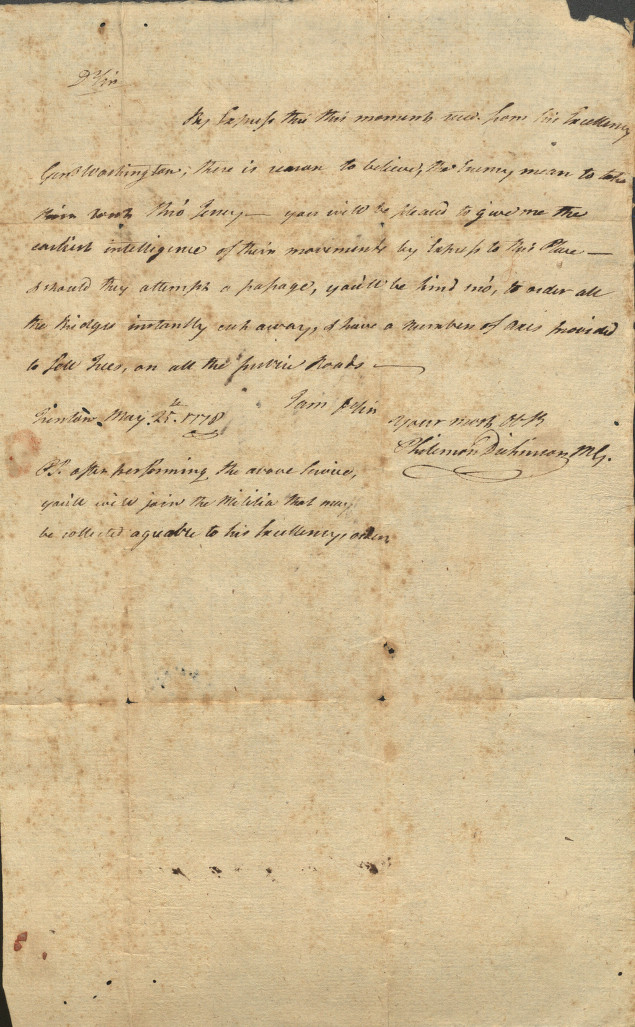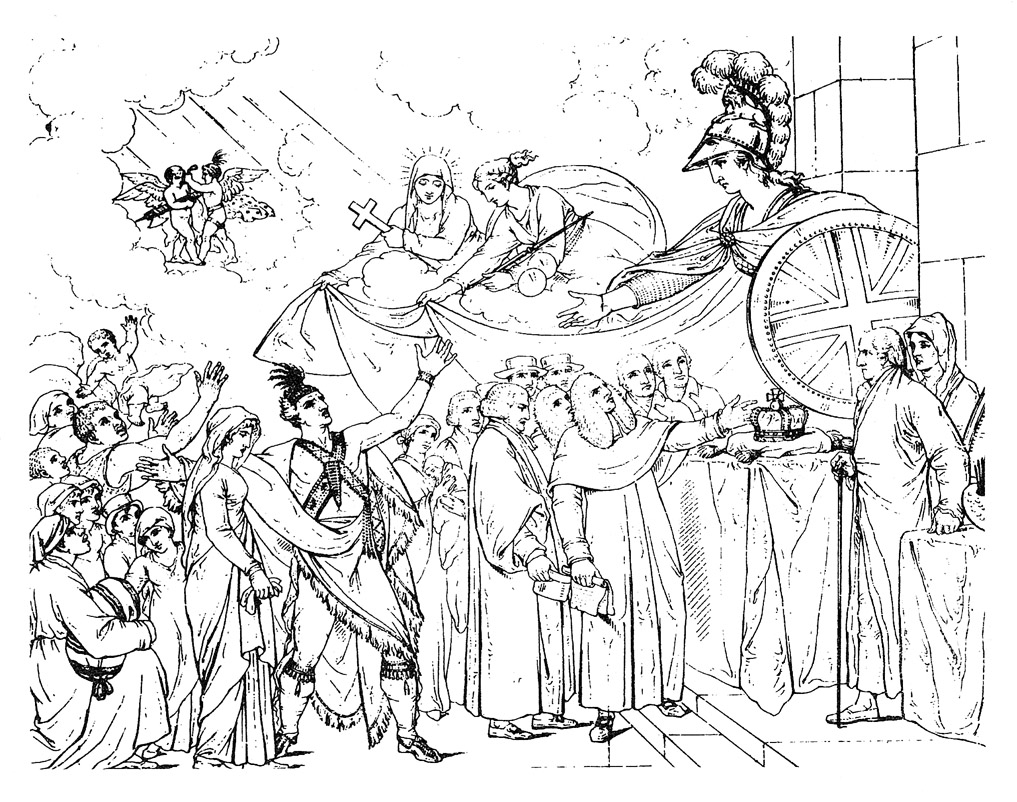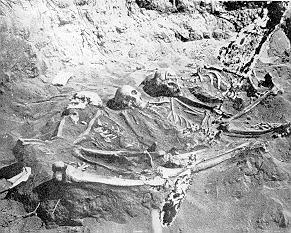|
Philemon Dickinson
Philemon Dickinson (April 5, 1739February 4, 1809) was an American lawyer and politician from Trenton, New Jersey. As a brigadier general of the New Jersey militia, he was one of the most effective militia officers of the American Revolutionary War. He was also a Continental Congressman from Delaware and a United States Senator from New Jersey. Background Philemon Dickinson was born at "Crosiadore," near Trappe, Maryland on April 5, 1739, a younger brother of Founding Father John Dickinson. When he was one, his family moved to Delaware. He was educated by a private tutor until he went to the University of Pennsylvania, from where he graduated in 1759. He then studied law, and was admitted to the bar, but never practiced. In 1767, Dickinson moved to Trenton to an estate called " The Hermitage". On July 14, 1767, he married his first cousin, Mary Cadwalader (1746–1781). They had two children; Samuel (1770–1837) and Mary (1768–1822). Military service Dickinson served as ... [...More Info...] [...Related Items...] OR: [Wikipedia] [Google] [Baidu] |
New Jersey
New Jersey is a U.S. state, state in the Mid-Atlantic States, Mid-Atlantic and Northeastern United States, Northeastern regions of the United States. It is bordered on the north and east by the state of New York (state), New York; on the east, southeast, and south by the Atlantic Ocean; on the west by the Delaware River and Pennsylvania; and on the southwest by Delaware Bay and the state of Delaware. At , New Jersey is the List of U.S. states and territories by area, fifth-smallest state in land area; but with close to 9.3 million residents, it ranks List of U.S. states and territories by population, 11th in population and List of U.S. states and territories by population density, first in population density. The state capital is Trenton, New Jersey, Trenton, and the most populous city is Newark, New Jersey, Newark. With the exception of Warren County, New Jersey, Warren County, all of the state's 21 counties lie within the combined statistical areas of New York City or Delaw ... [...More Info...] [...Related Items...] OR: [Wikipedia] [Google] [Baidu] |
Bar Association
A bar association is a professional association of lawyers as generally organized in countries following the Anglo-American types of jurisprudence. The word bar is derived from the old English/European custom of using a physical railing to separate the area in which court business is done from the viewing area for the general public. Some bar associations are responsible for the regulation of the legal profession in their jurisdiction; others are professional organizations dedicated to serving their members; in many cases, they are both. In many Commonwealth jurisdictions, the bar association comprises lawyers who are qualified as barristers or advocates in particular, versus solicitors (see '' bar council''). Membership in bar associations may be mandatory or optional for practicing attorneys, depending on jurisdiction. Etymology The use of the term '' bar'' to mean "the whole body of lawyers, the legal profession" comes ultimately from English custom. In the early 16th ... [...More Info...] [...Related Items...] OR: [Wikipedia] [Google] [Baidu] |
New Jersey Legislative Council
The New Jersey Legislative Council was the upper house of the New Jersey Legislature under the New Jersey Constitution of 1776 until it was replaced by the New Jersey Senate under the Constitution of 1844. History The Legislative Council replaced the New Jersey Provincial Council, which had been the upper house under colonial rule. The Provincial Council consisted of up to twelve members, appointed by and serving at the pleasure of the British crown. As this created an overly aristocratic and non representative body, the framers of the 1776 state constitution provided for an elected Legislative Council, with one Member of Council elected in each county for a one-year term. This structure would remain in place after 1844, when the Legislative Council would be replaced by the New Jersey Senate, and continued until 1965. Composition The 1776 Constitution set up a fusion of powers system of state government, which allowed for an overlap of executive, legislative and judicial au ... [...More Info...] [...Related Items...] OR: [Wikipedia] [Google] [Baidu] |
Thomas Conway
Thomas Conway (February 27, 1735 – c. 1800) served as a major general in the American Continental Army during the American Revolutionary War. He became involved with the alleged Conway Cabal with Horatio Gates. He later served with Émigré forces during the French Revolutionary War. Early life Conway was born in County Kerry, Ireland to James Conway and his wife Julieanne Conway. Though born to a Catholic family, it is unclear how closely he adhered to the faith. As a child, he immigrated to France with his parents. At 14, he enrolled in the Irish Brigade of the French Army and rose rapidly to colonel by 1772. Arrival in America Following the outbreak of the American Revolutionary War he volunteered to the Congress for service with the American rebels in 1777. Based on an introduction from Silas Deane, the Congress appointed him a brigadier general on May 13, and sent him on to George Washington. Conway commanded the leading brigade on the American right flank at the Battl ... [...More Info...] [...Related Items...] OR: [Wikipedia] [Google] [Baidu] |
John Cadwalader (general)
John Cadwalader (January 10, 1742 – February 10, 1786) was a commander of Pennsylvania troops during the American Revolutionary War and served under George Washington. He was with Washington at Valley Forge. Early life John Cadwalader was born in Trenton, New Jersey of Quaker parentage, the eldest son of Thomas Cadwalader (1707–1779) and Hannah Lambert, his wife.Historical Society of PennsylvaniaKent, p. 15 In 1750, the Cadwalader family removed to Philadelphia where John and Lambert Cadwalader, his brother, were merchants. In 1768 he was elected to the American Philosophical Society. On September 25, 1768, John Cadwalader married Elizabeth Lloyd (1742–1776), the daughter of Edward Lloyd, of Talbot County, Maryland. Her brother, Edward Lloyd IV, was a delegate to the Continental Congress for Maryland. Their daughter, Maria Cadwalader (1776–1811), married Samuel Ringgold, who became a congressman representing Maryland. Two of their sons, Samuel Ringgold and Cadwal ... [...More Info...] [...Related Items...] OR: [Wikipedia] [Google] [Baidu] |
Battle Of Monmouth
The Battle of Monmouth, also known as the Battle of Monmouth Court House, was fought near Monmouth Court House in modern-day Freehold Borough, New Jersey on June 28, 1778, during the American Revolutionary War. It pitted the Continental Army, commanded by General George Washington, against the British Army in North America, commanded by General Sir Henry Clinton. It was the last battle of the Philadelphia campaign, begun the previous year, during which the British had inflicted two major defeats on Washington and occupied Philadelphia. Washington had spent the winter at Valley Forge rebuilding his army and defending his position against political enemies who favored his replacement as commander-in-chief. In February 1778, the French-American Treaty of Alliance tilted the strategic balance in favor of the Americans, forcing the British to abandon hopes of a military victory and adopt a defensive strategy. Clinton was ordered to evacuate Philadelphia and consolidate his army. ... [...More Info...] [...Related Items...] OR: [Wikipedia] [Google] [Baidu] |
Jacob Van Buskirk
Jacob Van Buskirk (1760 – November 27, 1834) was a merchant, judge and political figure in Nova Scotia. He represented Shelburne County in the Nova Scotia House of Assembly from 1805 to 1818. He was born in Bergen County, New Jersey, the son of Abraham Van Buskirk and Sophia Van Dam. He was a lieutenant in the loyalist New Jersey Volunteers during the American Revolution. He was captured on Staten Island in 1777 by General Philemon Dickinson but then released and rejoined his regiment. In 1781, he was wounded at Eutaw Springs. After the war, Van Buskirk settled in the Shelburne, Nova Scotia Shelburne is a town located in southwestern Nova Scotia, Canada. History Shelburne lies at the southwest corner of Nova Scotia, at roughly the same latitude as Portland, Maine in the United States. The Mi'kmaq call the large and well-sheltered ... region in 1783. In 1790, he married Sarah Breen. He originally planned on farming but some time later established himself as a mer ... [...More Info...] [...Related Items...] OR: [Wikipedia] [Google] [Baidu] |
New Jersey Volunteers
The New Jersey Volunteers, also known as Jersey Volunteers, "Skinners", Skinner's Corps, and Skinner's Greens (due to their green wool uniform coats), were a British provincial military unit of Loyalists, raised for service by Cortlandt Skinner, during the American Revolutionary War. Regiment formed in Province of New York In 1776, American loyalist soldiers, formed the New Jersey Volunteers, which was raised in Province of New York, first, as three battalions and eventually as six, of 500 men each. Garrison duty The New Jersey Volunteers saw their first combat at the Battle of Long Island, during the British New York Campaign offensive and following the defeat and flight, of the Patriot forces, was assigned to the initial British garrison, of the occupation army, in New York City. Campaigns Brigadier General Cortlandt Skinner conducted regular operations, in the region north of New York City, in Westchester County, New York, between Morrisania and the Croton Rivers, wh ... [...More Info...] [...Related Items...] OR: [Wikipedia] [Google] [Baidu] |
Cortlandt Skinner
Cortlandt Skinner (December 16, 1727 – March 15, 1799) was the last Royal Attorney General of New Jersey and a brigadier general in a Loyalist force, the New Jersey Volunteers, also known as Skinner's Greens, during the American Revolutionary War. Before the Revolution Cortlandt Skinner was born December 16, 1727, to a wealthy family in Perth Amboy in the British Province of New Jersey, the eldest son of the Reverend William Skinner and Elizabeth ''nee'' Cortland. His grandfather Stephanus Van Cortlandt had been the first native born mayor of New York. Skinner was of English, Dutch and possibly Scottish ancestry. There was a firm family tradition that William Skinner, later the Rector of St. Peter's Church in Perth Amboy, had participated in one of the Jacobite risings and was related to the chiefs of the Clan Gregor – changing his name from MacGregor to avoid the persecution inflicted upon all those of that name. Skinner studied law at Newark while clerking for David Ogd ... [...More Info...] [...Related Items...] OR: [Wikipedia] [Google] [Baidu] |
Loyalist (American Revolution)
Loyalists were colonists in the Thirteen Colonies who remained loyal to the British Crown during the American Revolutionary War, often referred to as Tories, Royalists or King's Men at the time. They were opposed by the Patriots, who supported the revolution, and called them "persons inimical to the liberties of America." Prominent Loyalists repeatedly assured the British government that many thousands of them would spring to arms and fight for the crown. The British government acted in expectation of that, especially in the southern campaigns in 1780–81. Britain was able to effectively protect the people only in areas where they had military control, and in return, the number of military Loyalists was significantly lower than what had been expected. Due to the conflicting political views, loyalists were often under suspicion of those in the British military, who did not know whom they could fully trust in such a conflicted situation; they were often looked down upon. Pat ... [...More Info...] [...Related Items...] OR: [Wikipedia] [Google] [Baidu] |
Staten Island
Staten Island ( ) is a borough of New York City, coextensive with Richmond County, in the U.S. state of New York. Located in the city's southwest portion, the borough is separated from New Jersey by the Arthur Kill and the Kill Van Kull and from the rest of New York by New York Bay. With a population of 495,747 in the 2020 Census, Staten Island is the least populated borough but the third largest in land area at . A home to the Lenape indigenous people, the island was settled by Dutch colonists in the 17th century. It was one of the 12 original counties of New York state. Staten Island was consolidated with New York City in 1898. It was formally known as the Borough of Richmond until 1975, when its name was changed to Borough of Staten Island. Staten Island has sometimes been called "the forgotten borough" by inhabitants who feel neglected by the city government. The North Shore—especially the neighborhoods of St. George, Tompkinsville, Clifton, and Stapleton—is ... [...More Info...] [...Related Items...] OR: [Wikipedia] [Google] [Baidu] |
Millstone, New Jersey
Millstone is a borough in Somerset County, New Jersey, United States. It was originally known as Somerset Courthouse and was the county seat. As of the 2010 United States Census, the borough's population was 418,DP-1 - Profile of General Population and Housing Characteristics: 2010 for Millstone borough, Somerset County, New Jersey , . Accessed February 13, 2013. [...More Info...] [...Related Items...] OR: [Wikipedia] [Google] [Baidu] |






